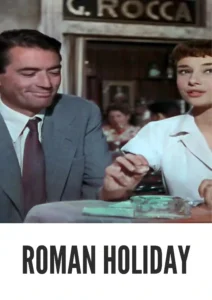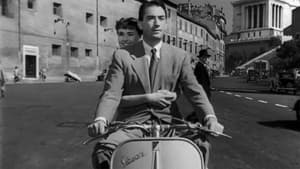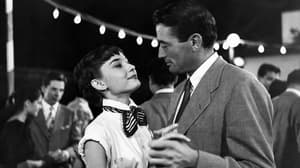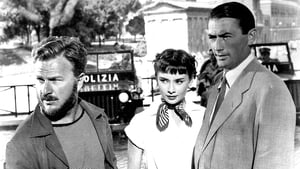Contact: info@alwanfilm.com
Video Sources 0 Views
- Watch trailer
- Roman Holiday

Synopsis
Table of Contents
ToggleUnraveling the Charm of a Classic: Exploring Roman Holiday 1953 Colorized Review

Genre: Romance/Comedy
Director: William Wyler
Cast: Audrey Hepburn, Gregory Peck, Eddie Albert
Introduction
“Roman Holiday” (1953) remains a timeless classic that has enchanted audiences for decades with its captivating storyline and unforgettable performances. As we embark on a journey through the streets of Rome with Princess Ann and Joe Bradley, we unravel the significance of this early colored version and its enduring legacy in the world of cinema.
Check The Full Colorized Movies List
Check Our Colorized Movies Trailer Channel
Understanding Roman Holiday 1953 Colorized: Director, Cast, and Genre
Directed by the legendary William Wyler, “Roman Holiday” boasts a stellar cast led by Audrey Hepburn, Gregory Peck, and Eddie Albert. Wyler’s deft direction brings to life the enchanting romance between a runaway princess and an American journalist against the backdrop of Rome’s iconic landmarks. Within the romance/comedy genre, the film strikes a perfect balance between humor, romance, and heartfelt emotion.
Exploring the World of Roman Holiday 1953 Colorized: Plot and Characters
“Roman Holiday” transports viewers into the whimsical world of Princess Ann, who embarks on a secret adventure through the streets of Rome after escaping her royal duties. Along the way, she crosses paths with Joe Bradley, an American journalist who becomes her unwitting accomplice in a day of spontaneous exploration and unexpected romance. As the two characters navigate the complexities of duty, freedom, and love, they forge a bond that transcends societal boundaries and captures the hearts of audiences worldwide.
The Art of Film Colorization
Film colorization has emerged as a transformative technique that breathes new life into classic works of cinema, adding depth and vibrancy to their visual presentation. In the case of “Roman Holiday,” colorization enhances the film’s timeless charm, immersing viewers in the vibrant landscapes of Rome and accentuating the chemistry between its beloved characters. While purists may debate the merits of colorization, its ability to introduce classic films to new audiences and preserve their legacy for future generations is undeniable.
Early Colored Films: A Brief History
The evolution of early colored films traces back to the pioneering efforts of filmmakers who sought to add color to the silver screen. From hand-tinted frames to sophisticated colorization techniques, the journey of color in cinema reflects a desire to enhance the visual storytelling experience and captivate audiences with its vivid imagery. “Roman Holiday” stands as a testament to the enduring allure of early colored films and their ability to transport viewers to distant worlds filled with romance, adventure, and intrigue.
“Roman Holiday” and Its Early Colored Version
The decision to release “Roman Holiday” in a colorized format speaks to a desire to introduce the film to new audiences and breathe new life into its timeless narrative. By adding color to the film’s enchanting locales and memorable characters, filmmakers aim to enhance the viewing experience while preserving its artistic integrity. While some may argue that colorization alters the film’s original aesthetic, others view it as an opportunity to rediscover a beloved classic in a fresh and exciting way.
The Debate Over Film Colorization
The debate over film colorization remains a contentious topic within the film community, with proponents and critics voicing their opinions on its artistic merits and ethical implications. While some embrace colorization as a means of revitalizing classic works for modern audiences, others argue that it compromises the integrity of the original film and undermines the filmmaker’s vision. Ultimately, the decision to colorize a film is a nuanced one that requires careful consideration of its historical significance and cultural impact.
Examining “Roman Holiday” as an Early Colored Film
As we examine “Roman Holiday” in its early colored version, we are greeted with a visual feast of vibrant hues and stunning cinematography. The addition of color enriches the film’s iconic locales, from the bustling streets of Rome to the tranquil beauty of the Italian countryside, enhancing the viewer’s immersion in Princess Ann and Joe’s enchanting adventure. While purists may prefer the classic black-and-white aesthetic, the colorized version offers a fresh perspective on the film’s timeless romance and enduring appeal.
Influence and Legacy: Roman Holiday 1953 Colorized’s Impact on Cinema
“Roman Holiday” has left an indelible mark on the world of cinema, inspiring countless filmmakers and captivating audiences with its timeless charm and heartfelt storytelling. Its enduring legacy can be seen in subsequent works that draw inspiration from its themes of love, adventure, and self-discovery. From its iconic performances to its enchanting locales, “Roman Holiday” continues to enchant audiences around the globe, proving that true love knows no boundaries.
Director’s Cinematic Legacy: Beyond Roman Holiday 1953 Colorized
William Wyler’s directorial legacy extends far beyond “Roman Holiday,” encompassing a diverse body of work that has earned him critical acclaim and accolades throughout his career. From epic dramas to intimate character studies, Wyler’s films resonate with audiences on a profound level, exploring the complexities of the human experience with depth and authenticity. His contributions to cinema serve as a testament to the enduring power of storytelling and the transformative impact of great filmmaking.
Themes Explored in Roman Holiday 1953 Colorized
“Roman Holiday” explores a myriad of themes that resonate with audiences of all ages, from the exhilaration of newfound freedom to the bittersweetness of forbidden love. At its core, the film celebrates the joy of embracing life’s adventures, seizing the moment, and following one’s heart, even in the face of uncertainty. Its timeless message of courage, compassion, and self-discovery continues to inspire viewers to embrace life’s journey with open arms and an open heart.
Reception and Controversy Surrounding Roman Holiday 1953 Colorized
Upon its release, “Roman Holiday” received widespread critical acclaim, earning numerous accolades, including three Academy Awards. Audiences were captivated by its enchanting storyline, stellar performances, and breathtaking cinematography. However, the film’s colorized release sparked controversy among purists, reigniting the debate over the ethics of altering classic works of cinema. Despite the mixed reception, “Roman Holiday” remains a beloved classic that continues to enchant audiences of all ages.
Where to Watch Roman Holiday 1953 Colorized Online
For viewers eager to experience the magic of “Roman Holiday,” the film is readily available on popular streaming platforms. Whether in its original black-and-white format or early colored version, audiences can immerse themselves in the timeless romance and enchanting beauty of Princess Ann and Joe’s unforgettable journey through the streets of Rome.
FAQs About Roman Holiday 1953 Colorized
1. Why was “Roman Holiday” chosen for colorization?
- The decision to colorize “Roman Holiday” was driven by a desire to introduce classic films to new audiences and provide existing fans with a fresh viewing experience. Additionally, colorization aimed to enhance the film’s visual appeal and showcase its timeless charm in a vibrant new light.
2. Does colorization alter the integrity of the original film?
- Colorization has been a subject of debate within the film community, with purists arguing that it compromises the artistic integrity of the original work. However, proponents contend that colorization offers a new perspective on classic films without detracting from their inherent value.
3. How does colorization impact the viewing experience of “Roman Holiday”?
- Colorization adds depth and vibrancy to “Roman Holiday,” enriching the film’s iconic locales and memorable characters with vivid hues and stunning cinematography. While some may prefer the classic black-and-white aesthetic, colorization offers a fresh interpretation of the film’s timeless romance and enduring appeal.
4. Is the original black-and-white version still available for viewing?
- Yes, the original black-and-white version of “Roman Holiday” remains accessible to viewers who prefer to experience the film in its intended format. Many streaming platforms offer both the colorized and original versions, allowing audiences to choose according to their preferences.
5. How does colorization impact the film’s historical accuracy?
- Colorization can enhance the visual authenticity of historical settings, providing viewers with a more immersive experience. However, it is essential to acknowledge that colorization is an interpretive process and may not always accurately reflect the historical context of the film.
6. Are there any significant differences between the colorized and original versions of “Roman Holiday”?
- While the core narrative remains unchanged, colorization introduces subtle differences in visual aesthetics and atmosphere. Certain scenes may evoke different emotions or highlight previously unnoticed details, offering viewers a fresh perspective on the film’s themes and characters.
7. How has the reception been to the colorized version of “Roman Holiday”?
- Reception to the colorized version of “Roman Holiday” has been mixed, with some audiences embracing the enhanced visual presentation and others expressing reservations about altering a classic film. Ultimately, individual preferences and opinions shape the overall reception of the colorized version.
8. Will other classic films receive similar colorization treatments in the future?
- The decision to colorize classic films depends on various factors, including audience demand, technological advancements, and preservation efforts. While some films may benefit from colorization, others may remain untouched to preserve their original artistic vision.
Conclusion
“Roman Holiday” stands as a timeless masterpiece that continues to enchant audiences with its captivating storyline, unforgettable performances, and breathtaking cinematography. Whether experienced in its original black-and-white format or early colored version, the film’s timeless charm and universal appeal resonate with viewers of all ages, reminding us of the enduring power of love, adventure, and the magic of cinema. As we embark on this enchanting journey through the streets of Rome, we are reminded that true love knows no boundaries and that every moment is an opportunity for adventure and self-discovery.




















